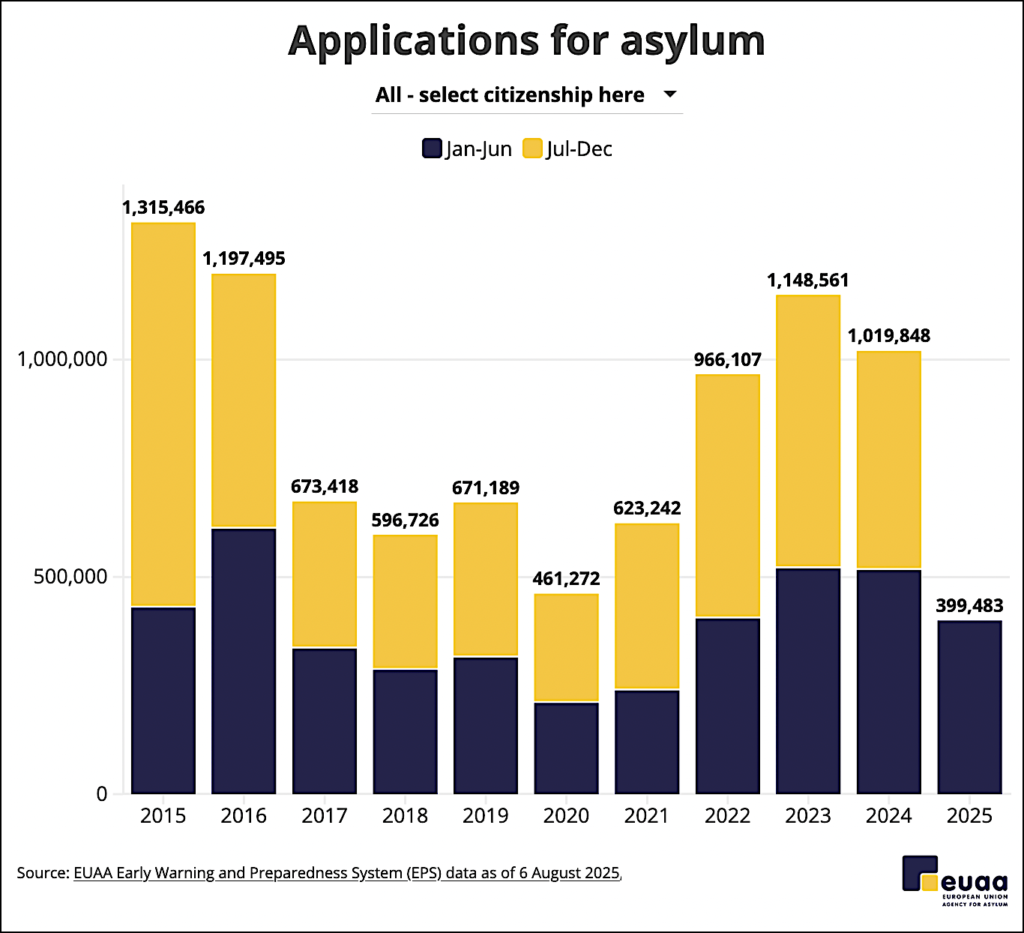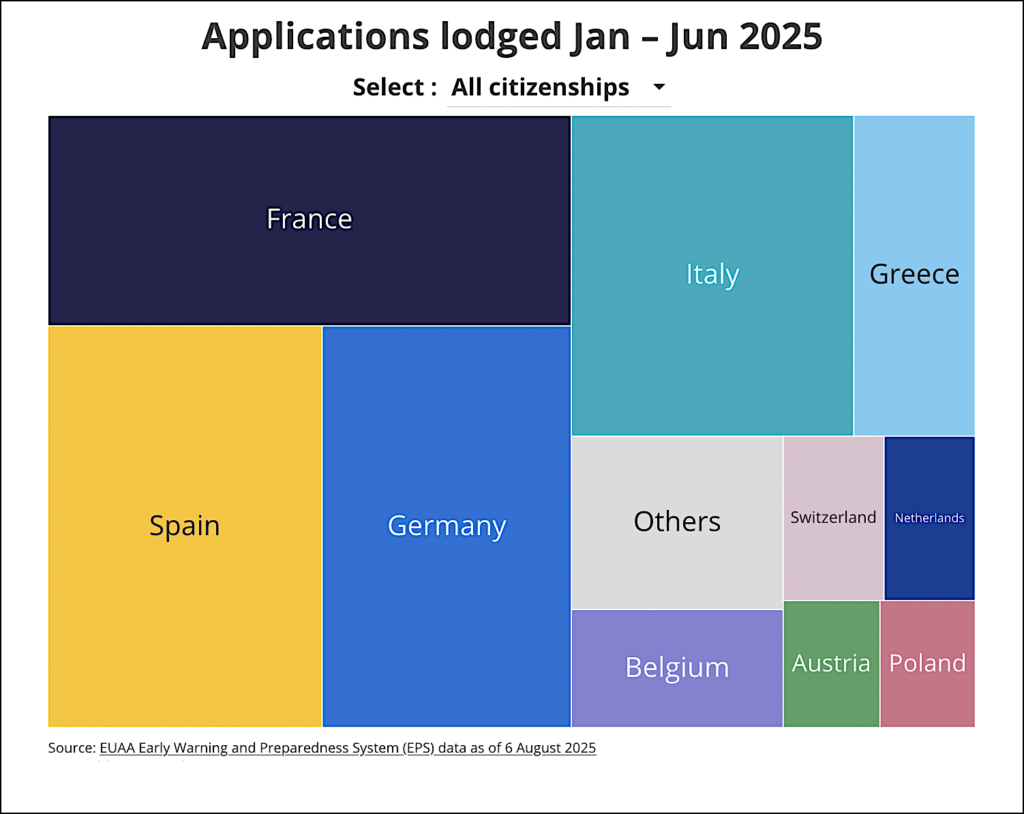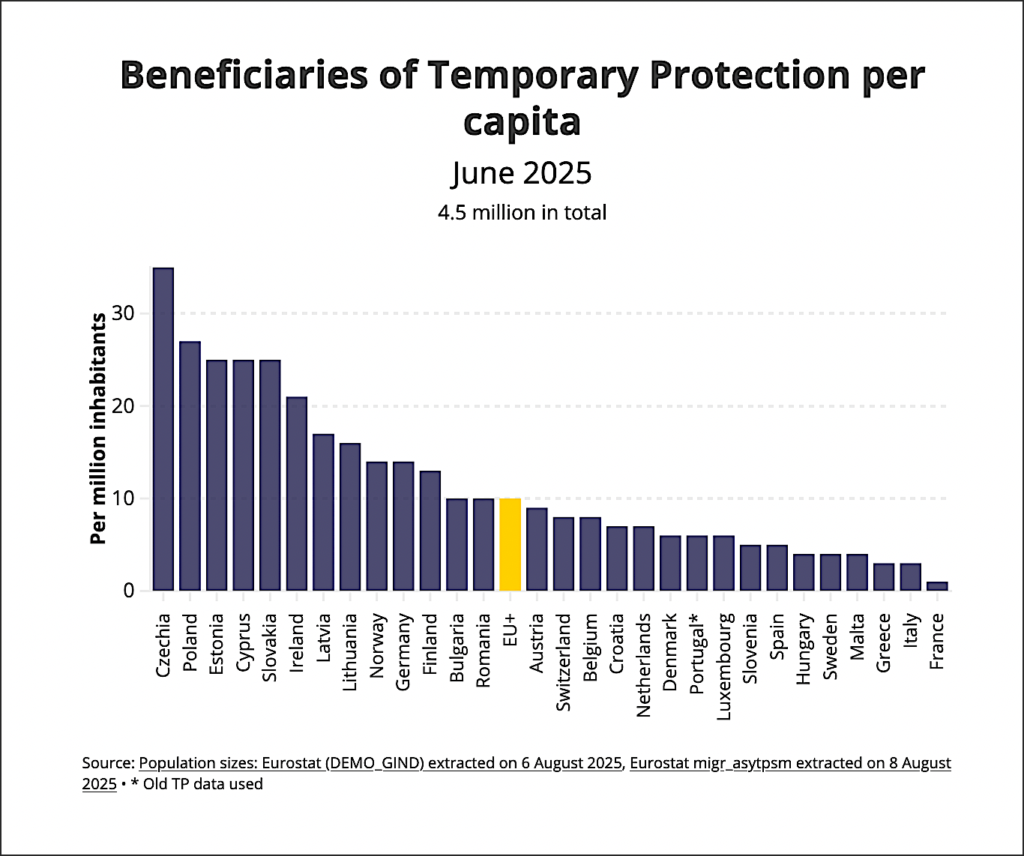Afghan refugees in a church © EDM
Europe’s asylum landscape underwent a series of significant shifts in the first half of 2025. By the end of June, EU+ countries received 399 000 asylum applications, a 23 % decrease year-over-year. A two-thirds drop in Syrian applications meant that Germany was no longer the main receiving EU+ country, with both France and Spain receiving more applications. A majority of applications continued to be lodged by citizenships with low recognition rates in the EU+.
The European Union Agency for Asylum (EUAA) has just published its Mid-Year Review of the Latest Asylum Trends, paired with detailed analysis of the main citizenships seeking asylum and the key European countries receiving their applications. By the end of June 2025, EU+ countries received 399 000 asylum applications, a 23 % decrease compared to the first half of 2024. This shift was driven by far fewer Syrians (25 000) applying, for whom the number of applications dropped by two thirds (- 66 %). However, Venezuelans (49 000) applied in significant numbers, up by almost a third (+ 31 %) year-over-year.
| Changing trends belay a complex asylum landscape
Following the fall of the Assad regime in Syria last December, and after a decade during which Syrians were consistently the main citizenship seeking protection in the EU+, Venezuelans became the largest nationality group in the first half of 2025. This shift had a significant impact on the main receiving EU+ countries of asylum applications. By the end of June, France (78 000) and Spain (77 000) both received more applications than Germany (70 000). They were followed by Italy (64 000) and Greece (27 000). Greece received the most applications per capita: 1 application for every 380 residents. Importantly, while the number of applications in France was stable, year-over-year, applications in Germany (- 3 %), Italy (- 25 %) and Spain (- 13 %) all fell compared to the first half of 2024.

Third country nationals tend to favour specific EU+ countries when seeking international protection. Venezuelans tend to apply in Spain due to a shared language, an existing diaspora and a tendency by the Spanish authorities to grant them a national form of protection. Indeed, Venezuelans lodged almost all of their applications in Spain (93 %). Compounding this reality, Venezuelan applications in Spain also rose by almost a third (+ 29 %), compared to the first half of 2024. Typically, around a quarter of asylum applications in the EU+ are lodged by citizenships with visa-free access to the Schengen area. Venezuelans and Colombians represent the majority of such applicants. The European Parliament is expected to vote on a stronger and more flexible visa suspension mechanism soon.

In addition to Venezuelans, other citizenships displayed increased trends. Ukrainians (16 000) have continued to lodge increasing numbers of asylum applications, also up by 29 %. France accounted for nearly half of all Ukrainian applications, whereas Poland accounted for almost one third. However, these figures were dwarfed by the 4.3 million Ukrainian beneficiaries of temporary protection at the end of June 2025.
Afghans (42 000) were the second largest applicant group in the first half of 2025. Despite representing a tenth of all applications, the semi-annual figure has been on a downward trend since 2023. Following Syrians, Bangladeshis (17 000) and Turks (17 000) also lodged fewer applications, recording decreases of 26 % and 41 %, respectively, year-over-year.
In addition to asylum applications, at the end of June 2025, approximately 4.5 million individuals were benefiting from temporary protection in the EU+. This figure has remained relatively stable since early 2023 but continues to significantly contribute to the overall number of people in the EU+ with protection needs.
| Temporary Protection
Temporary protection is granted under the 2001 Temporary Protection Directive, which was activated for the first time in 2022 in response to the Russian invasion of Ukraine, enabling the rapid and effective provision of assistance to those displaced to the EU+. For further details, refer to the EUAA report on the Application of the Temporary Protection Directive.

At the end of June 2025, nearly half of all beneficiaries of temporary protection were in Germany (1.2 million) and Poland (just under 1 million, based on Eurostat data). To provide comparative context alongside asylum application inflows, Figure 12 illustrates the number of beneficiaries of temporary protection per capita across EU+ countries.
For instance, Czechia hosted approximately 378,000 beneficiaries, equating to 35,000 per million inhabitants, or 1 beneficiary for every 29 residents. Meanwhile, Slovakia and Cyprus were hosting very different numbers of beneficiaries (133,000 and 24,000, respectively) yet exhibited the same per capita distributions, with each hosting 1 beneficiary for every 41 residents.
The Council of the EU has extended temporary protection for people fleeing Russia’s aggression against Ukraine until 4 March 2027.
.

